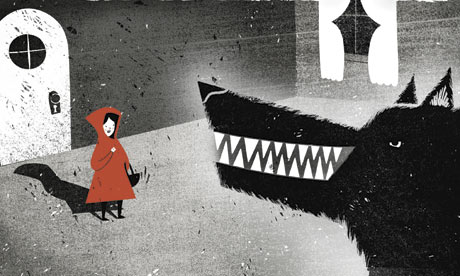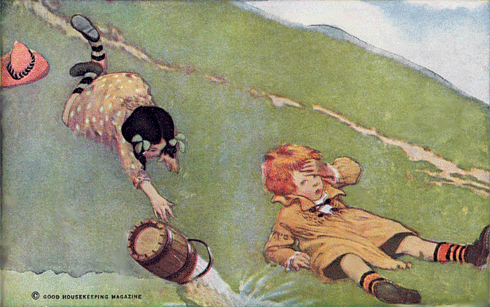When it comes to identifying and analyzing symbolism in literature, students often find themselves struggling.
I am planning to cover Edgar Allan Poe's "Masque of the Red Death", which is already challenging for many students due to its somewhat outdated language without the added pressure of analyzing the author's use of symbolism.
So I asked myself, 'what can I do to help ease them into identifying symbolism in literature?'
Well, we started like any new reader would--with nursery rhymes and fairy tales.
 |
| Source:http://static.guim.co.uk/sys-images/Guardian/About/General/2009/9/28/1254148878993/Little-Red-Riding-Hood-me-001.jpg |
Why such simple and perhaps even elementary fare?
Actually, it's exactly for those reasons. Many students are already familiar with nursery rhymes such as Humpty Dumpty and Jack and Jill. The reading is almost ridiculously easy.
However, our goal is for students to think symbolically as they read these stories. To ask themselves, "What here might stand for something else?"
However, our goal is for students to think symbolically as they read these stories. To ask themselves, "What here might stand for something else?"
And nursery rhymes and fairy tales are rife with archetypes and symbols. After all, fairy tales are what our ancestors used to instill their values in their offspring and they are still in use today for that same purpose.
So let's get started!
Pre-Assessment / Warm-up
Have students write down in their journals:
- A definition of the word, "symbol", in their own words.
- 3 examples of symbolism
 |
| A student's journal entry. You can see that he already has an innate sense of symbolism. |
Afterwards, choose a random selection of students to share their definitions with the class. Write down the relevant pieces to come up with the class's working definition of SYMBOLISM. Also have students share one or two of their symbols.
Presentation
As a class, go over what concrete and abstract mean and brainstorm concrete nouns and abstract nouns.
My students came up with a variety of concrete nouns including: person, computer, paper, flower, and pen. For abstract nouns, they came up with: love, peace, freedom, liberty, pursuit of happiness, sadness...etc.
(You can tell that they had gone over the Declaration of Independence recently in their social studies classes).
I used one of my students' ideas (pen) to again illustrate the connection between the concrete and the abstract in symbolism.
me: There is a well known proverb which states that the pen is mightier than the sword. Is this literally true? If you were in a fight and the other guy had a huge knife and all you had was a ball point pen, would you win?
students: (laughing) No!
me: So that means that pen and sword here have symbolic meanings. They are concrete objects that stand in for more abstract concepts. What do you think the pen really means?

We established that the pen stands for knowledge, smarts, and peace.
And that the sword probably stands for force, might, and war.
Modeling
Read a simple nursery rhyme together with your class. We read Jack and Jill and Humpty Dumpty. You may choose to do only one rhyme depending on the time constraints.
 |
| Source: http://www.mamalisa.com/images/mother_goose/jackandjill_willcox.gif |
Jack and Jill went up the hill to fetch a pail of
water
Jack fell down and broke his crown
And Jill came tumbling after.
Up got Jack, and home did trot
As fast as he could caper
He went to bed and bound his head
With vinegar and brown paper.
I asked the students:
- What does the hill symbolize?
- What might the fall represent?
- What two different definitions does the word, "crown", have? What do you think it means here?
- What does Jack falling down to break his crown represent?
My students came up with rather insightful answers. They recognized that the hill goes up and down like life and life's obstacles. The fall represents hitting a low point in your life. Crown can mean your head or the thing that kings wear. Maybe Jack is a king or high person who ran into hard times and lost his throne.
After hearing students' interpretations, I shared the historical origins of the Jack and Jill nursery rhyme, which actually is the story of King Louis XVI and his queen Marie Antoinette. The aristocracy of France had lost touch with the way the commoners were suffering and kept raising taxes until the angry commoners had an uprising. The king and his queen were beheaded on the guillotine, losing their crowns literally and figuratively.
 |
| Source: http://thebrightestman.wikispaces.com/file/view/Guillotine_Louis_XVI.jpg/129302097/Guillotine_Louis_XVI.jpg |
Activity
 |
| Students working together in pairs. (They were too shy for the camera so I had to take a picture from the back). |
Divide students into pairs or groups of 3-4 and assign them a fairy tale to read. Each story has several guidance questions.
For example for Little Red Riding Hood
- What do you think the color red symbolizes here? What does it mean that the little girl wears her little red velvet cap everyday?
- Why does the story take place in the woods? How would the story be different if her grandmother lived in town?
- What does the wolf symbolize?
- What is the message here? What is the lesson to be learned?
We had discussed active reading strategies such as SQ3R in a previous class. So the students knew that they were to scan the story beforehand and read the guidance questions before reading. I reminded them to read the questions first and to use highlighters to highlight what they thought might be clues or answers to the guidance questions as they actively read the stories for symbols.
 |
| A student highlighting as he actively reads for answers to the guidance questions and for symbolism. |
As the students worked together, I walked around the room listening to their discussions and gain a sense of how each student was doing.
Some students needed me to prompt them with more questions in addition to the guidance questions already written at the top of the story.
For example, a group was having trouble with the question, "What does the wolf symbolize?"
me: What do you guys think the wolf might represent?
students: um... I don't really know. A wolf?
me: Do you think the same things would have happened if Little Red Riding Hood had met a bunny rabbit?
students: No!
me: What's the difference between a bunny rabbit and a wolf?
student: A bunny is fluffy and cute. And a wolf...it's scary and dangerous!
me: Good! So if the wolf was a person, what kind of person would he be?
...etc
After the groups have had plenty of time (20-25 minutes) to complete their symbolism T-charts, go over their ideas together as a class. This is another opportunity to check on student comprehension.
Post-Assessment / Wrap-up
Using a different color pen, students return to their journals to write down explanations of what abstract ideas their symbols from the Warm-up Activity might stand for.
Thoughts and Reflections
The students have a clearer idea of symbolism. Their definitions have moved from simply "something that stands for something else" to incorporating the concrete and the abstract.
Students successfully identified symbols in the nursery rhymes and fairy tales and were able to explain their significance and meaning.
For example, the Red of the Little Red Riding Hood was not just a color she liked. It could also mean danger or boldness. It could also mean vanity or pride.
I liked using "the Little Red Riding Hood" because it already gets students thinking about the symbolic significance of color (an important motif throughout Poe's "Masque of the Red Death").
"The Ugly Duckling" was another story I used for the group activity. The Hans Anderson version uses seasons (spring as the Ugly Duckling is born, and moving through the seasons to winter when he is fully grown and knows his true worth) to represent the passage of time as well as the cycle of life. However, I think I might look for other fairy tales with themes and symbols more in line with Poe's for next time.
All in all, I am glad that I took the time to go over symbolism and how to identify and interpret it in simpler works before asking the students to do the same for Edgar Allan Poe's "Masque of the Red Death", which is a much challenging read. I hope that the students will be more confident trying to approach the symbolism in Poe than they might have been had I asked them to do so without modeling the process for them and having them practice it on easier and more approachable works.
 |
| A wonderfully nightmarish illustration by Olga Deineko, c. 1910 |





























